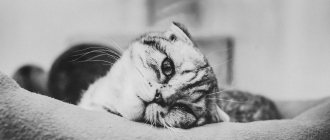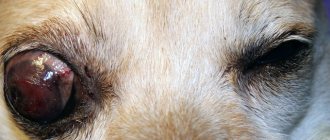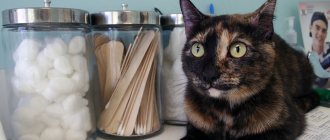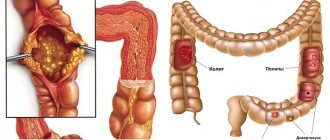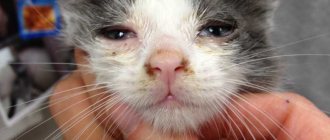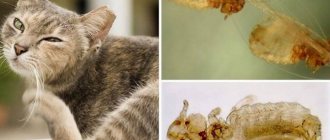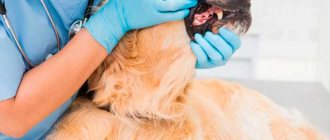Doctors often encounter misunderstandings among owners when they try to explain that the cat does not have constipation, but megacolon. What is the difference between these concepts?
Constipation (also referred to as constipation or constipation) is difficult or systematically insufficient defecation, that is, bowel movement.
Megacolon is a form of long-term constipation when the colon becomes full of hard and dried stool.
Constipation can most often be treated with medication, but sometimes it is necessary to resort to surgery.
Megacolon: what is it and its difference from constipation
Constipation is the most understandable and common name for a digestive problem in cats, also called constipation. It stands for a systematic violation of bowel movements, but the fact of defecation itself is present, albeit in a difficult form.
Megacolon is a long-term constipation in which the colon becomes overfilled with dry and very hard feces. It (usually) cannot be treated with medication and requires surgical intervention.
Treatment
The primary tasks are to relieve intoxication, eliminate dehydration, and evacuate feces using laxatives or an enema. Unfortunately, conservative treatment of megacolon in cats is rarely effective. Usually a subtotal colectomy is indicated - an operation to remove the problem area. Even if the cause is identified and eliminated, the distended intestines cannot be returned to normal.
First aid
You cannot help your pet on your own. Laxatives, emollients, and motility modulators can cause irreparable harm. Especially if we are talking about blockage of the lumen, neoplasm, internal bleeding, or a large accumulation of stones. Only a veterinarian can rule this out.
If it is impossible to show the cat to a doctor immediately, vegetable puree and non-acidic kefir are introduced into the diet. As a last resort, give a teaspoon of Vaseline oil or Duphalac at the rate of 0.5 ml per 1 kg of weight with a syringe without a needle. If you react with diarrhea, the next dose is given after 10 hours, reducing it by a third. The use of laxatives during obstruction can cause intestinal rupture!
Basic treatment
Resection of all or most of the colon is the removal of a “pocket” in which excrement accumulates. The healthy ends of the intestine are stitched together, restoring its function along its entire length. Stretched loops cannot be returned to normal with medications, although most owners insist on this attempt.
Doctors agree if there are no serious disturbances in the functioning of the body. Otherwise, it will be more difficult for the pet to endure anesthesia, which, even without taking into account other risks, makes postponing the operation unreasonable.
Therapy helps in mild cases, in the early stages and as a means of eliminating symptoms when surgery is unacceptable:
Mucofalk, Metamucil, Senade - plant extract stimulates the intestines with coarse fibers;
Duphalac, Normaze (lactulose) - increases osmotic pressure, softens stools, increases volume, stimulates peristalsis;
Enterosgel, Filtrumsti reduce intoxication;
Vaseline oil, petrolatum - without being absorbed, they facilitate the passage of masses through the intestines, preventing microtraumas;
Cisapiride is a strong laxative that stimulates gastrointestinal tone and motility;
SSD antibiotics suppress pathogenic flora.
The drugs are prescribed in the form of suspensions, suppositories, and enemas. If treatment does not help, the intestinal contents are evacuated mechanically under general anesthesia. Some owners prefer to take their cats for this procedure several times a year rather than decide to have the surgery done once. Practice indicates a temporary effect - they still come to the need for surgical intervention, but for acute indications.
Causes of the pathological condition
The breed or age of megacolon cats has not been identified, but, according to the observations of doctors at the RosVet EC, cats (65-70%) aged 5 to 8 years and smooth-haired cats (42-48%) are most often seen at the reception.
Animals with excess body weight (obesity) are at risk.
List of possible reasons:
- idiopathic megacolon develops as a primary disease if pathologies of the muscular wall of the intestine are present or contractility of the colon is impaired;
- pain of various origins that interferes with normal bowel movements (foreign body, intestinal abscesses, anal injury, joint problem that prevents one from taking a specific position);
- inconvenient tray (wrong place chosen, people and animals get in the way). Cats want to do their natural needs without witnesses and with comfort; failure to comply with these conditions provokes marks in the wrong places, constipation and megacolon;
- metabolic disorders (metabolism), a decrease in potassium and calcium in the blood leads to changes in intestinal motility, thyroid disease leads to dysfunction of the gastrointestinal tract;
- pathologies of the central nervous system (neurology), in particular lumbar injuries, tail fractures, spinal deformity;
- intestinal obstruction (tumors, strictures, foreign bodies, etc.);
- Dehydration causes the formation of dry and hard stool.
Any of these reasons can trigger megacolon. In addition, during treatment it is necessary to eliminate all provoking factors, otherwise the re-development of the pathology is inevitable.
Description
Megacolon is a chronic increase in the diameter of the large intestine, most often the colon. This is where electrolytes and moisture are absorbed from the stool. Usually the excrement moves further, accumulating before the act of defecation in the rectum. With megacolon in cats, the movement of masses ends in the thick section.
Excretion occurs due to peristalsis - wave-like contractions. Due to complete or partial loss of motility, a section of the intestine loses tone, increasing in diameter. A “pocket” is formed where feces accumulate, further drying out and pressing.
Soon the density and volume of the masses reach values that make the natural process of emptying impossible. Fecal stones irritate the intestinal walls, which, against the background of chronic intoxication, leads to a deterioration in the general condition of the cat. Megacolon without treatment leads to irreversible changes in the nerves and smooth muscles of the colon, peritonitis, sepsis, failure of internal organs, and perforation of the intestinal walls.
This is not a separate disease, but a clinical sign of a disease or pathology. Maine Coons, Himalayans and Persians are prone to megacolon due to the structure of their pelvis. In the absence of specific causes, megacolon in cats is most often diagnosed between the ages of 4 and 7 years, secondary - regardless of age.
Clinical signs
The cat owner notices behavioral changes; if normally, bowel movements go almost unnoticed, then with megacolon the animal constantly runs to the litter box, sits there for a long time, strains, and meows.
Gradually, her general condition worsens, the cat refuses food and becomes lethargic. If defecation is successful, the feces are very hard, dry, and small in volume. When the intestinal walls are damaged, there is blood and mucus.
The inability to empty the intestines provokes vomiting, so the overfilled stomach is freed from excess.
Prevention
It is important to understand that feline megacolon is not just constipation, but a progressive deformation of the intestines. A pet experiencing difficulty defecating should be shown to a doctor as soon as possible, without trying to solve the problem with improvised means. It is important to feed your cat properly, prevent ingestion of fur (comb it out on time), and vaccinate and vaccinate it in a timely manner.
Sick and postoperative cats are prescribed a lifelong high-fiber diet. Vegetable puree is mixed with chopped fish or meat, soaked dry food, and canned food. The food is liquid or semi-liquid, slightly above room temperature. Sour cream, bones, skin, offal, strong broths, fatty meat and fish are not allowed.
With each delay in defecation, it becomes more and more difficult for the cat to go to the toilet due to dehydration of the food coma. Therefore, it is very important to provide free access to the tray around the clock. If your pet is shy, it is advisable to buy a closed toilet-house and choose a secluded place for it. Feeding and emptying “clockwise” is the best prevention of megacolon and relapses.
Source
Diagnostic rules for megacolon
The disease is polyetiological, which means that the examination of the cat at the RosVet EC will be carried out taking into account all possible causes provoking megacolon. It is mandatory to collect:
- medical history (conditions of keeping, feeding, watering, etc.);
- data on the possibility of a cat swallowing foreign objects.
A neurological examination often includes a computed tomography scan with cerebrospinal fluid sampling. A colonoscopy is performed, the colon is examined endoscopically and samples are taken for cytological examination.
Ultrasound of the abdominal cavity and radiography make it possible to differentiate megacolon from constipation and coprostasis; this is important, since the treatment for all three pathological conditions is different. Using pictures (X-rays), you can visualize foreign bodies in the intestinal lumen and neoplasms.
To assess the general health of the cat, standard laboratory tests are performed: general and biochemical blood and urine tests. It is also recommended to check the functioning of the endocrine glands, in particular the thyroid hormone T4.
Therapeutic plan
Treatment will depend on the severity of the case and the condition of the sick animal. If something still comes out of the anus when you try to defecate, there is a considerable probability of spontaneous healing. If all is not lost, the problem can be solved by introducing food with a high fiber content into the cat's diet. To do this, you do not need to buy expensive feed, since regular bran and orange feed pumpkin are perfect for the same purpose.
When your cat is on a diet, it is very important to provide her with enough water. In some cases, rectal suppositories can be used, which also help get rid of mild forms of megacolon. Just remember that after inserting the suppository, the animal must be held, lightly massaging the anus area. They do this so that it doesn’t jump out.
Alas, in situations where constipation only progresses, the animal will have to be treated in a clinical setting. To remove accumulated feces, they resort to enemas with oils and laxative salts (Glauber's, for example). This procedure should only be performed by a qualified veterinarian. Enemas with a laxative effect are prescribed with extreme caution, since with advanced constipation they can lead to intestinal ruptures.
The specific treatment plan will depend on the severity of constipation and the underlying cause of the condition.
Medical therapy may not be needed for the first episodes of constipation. Initial episodes are often transient and resolve without therapy. Affected animals should always be rehydrated if dehydration has contributed to clinical signs.
Mild to moderate or recurring episodes of constipation usually require some medical intervention.
These cases can be managed, often in an outpatient setting, with diet, water enemas, oral or suppository laxatives, and/or colonic prokinetic agents.
Severe cases of constipation usually require short-term hospitalizations to correct metabolic disturbances and evacuate affected feces using water enemas, manual extraction of stored feces, or both.
Subsequent therapy in such cases is aimed at correcting predisposing factors and preventing relapses. Interim colectomy will become necessary in cats suffering from obstruction or idiopathic extended megacolon. These cats, by definition, do not respond to drug therapy.
Pelvic osteotomy without coloctomy may be sufficient for some cats with pelvic canal stenosis and hypertrophic megacolon.
Features of treatment of megacolon in cats
At the RosVet VC, two methods are used to treat megacolon: conservative (medicinal) and surgical. The choice of priority directly depends on the cause of the pathology and the general condition of the cat admitted for treatment.
Therapeutic (medicinal) method:
- if there is no critical dehydration of the body, then normal hydration is maintained by administering infusion solutions subcutaneously or intravenously;
- wet, bulky food and water are added to the diet to soften dry excrement in the intestines;
- provide access to the litter box that the cat likes (a secluded place, remove irritants, animals, etc.);
- cleanse the intestines of dense feces (enema, mechanical cleansing under anesthesia) to reduce injury to the walls and eliminate intoxication;
- intestinal prokinetics, drugs that improve peristalsis or laxatives are prescribed.
The use of lubricants that accelerate the passage of stones through the intestine is justified - this is Vaseline oil, administered rectally. The mistake is to give it by mouth, as this often provokes aspiration pneumonia if the oil gets into the lungs.
Lactulose, magnesium salts (not given in case of renal failure), polyethylene glycols (not given in case of intestinal obstruction) are hyperosmotic laxatives that “attract” excess moisture into the intestines and facilitate the excretion of feces
Surgery
Subtotal colectomy is a radical surgical solution used if other therapeutic methods are powerless for megacolon. The essence of the operation is to remove part of the colon in which fecal matter has frozen and has ceased to function normally.
The outcome of surgical intervention, as well as the prognosis, directly depends on the condition of the animal and the gastrointestinal tract at the time of the intervention. Age, the degree of damage to the intestinal walls, the length of the megacolon, and whether there is distension and perforation of the intestine are taken into account.
A common postoperative complication is loose stools, which may not go away for several months. But the veterinarians of the RosVet VC do everything to eliminate or minimize such gastrointestinal disorders, and also achieve the animal’s recovery in a short time.
It is important to know! A cat that has undergone treatment for megacolon will need to be on a diet for life. The owner needs to maintain normal living conditions and eliminate all factors that could trigger the re-development of the pathology.
If you notice that your cat is acting restless, cannot go to the toilet for a long time, but at the same time demonstrates its readiness to defecate - do not hesitate! Call the RosVet Center 24 hours a day and bring your pet for examination. The clinic's doctors are available 24 hours a day.
Symptoms of the disease
Against the background of such a pathology, the pet stops eating.
Common signs of the disease are associated with disruption of the process of fecal excretion. The cat may try to go to the toilet for a long time and return the tray several times. Sometimes she stops trying completely. In the first stages, involuntary bowel movements are possible. At a later stage, blood or mucus may be released along with the stool. This is a clear sign of an inflammatory process. Unlike diarrhea, stool is dry. Sometimes cats suffer from vomiting. There is a sharp decrease in weight, loss of appetite and dehydration. The cat becomes nervous and restless. If the origin of the disease lies in a disruption of the nervous system, then involuntary urination appears. Without treatment, megacolon in cats can lead to intestinal rupture or even lethargy.
How to prevent the development of rectal prolapse?
To prevent rectal prolapse in a cat, you need to follow simple recommendations . The first thing to do is to provide a balanced diet that will not lead to constant constipation or, conversely, diarrhea. On the recommendation of a veterinarian, your pet can be given vitamins that improve digestion and probiotics.
Other recommendations to help avoid prolapse:
- regularly carry out anthelmintic treatment,
- follow the schedule of routine vaccinations,
- provide timely treatment of primary diseases (prostatitis, cystitis, urolithiasis, etc.),
- prevent injury to the animal and ingestion of various foreign objects.
Rectal prolapse is a dangerous disease that, without timely treatment from a veterinarian in Moscow, can cost your pet’s life. If you notice rectal prolapse in your cat, seek help as quickly as possible. A specialist will examine your pet, quickly conduct all the necessary tests and select an effective treatment method.
Pathogenesis of idiopathic megacolon
The pathogenesis of idiopathic megacolon in dogs has historically been attributed to a primary neurogenic or degenerative neuromuscular disorder.
Although it seems clear that a small number of cases (11%) are the result of neurological disease, the vast majority (>90%) of cases do not have evidence of neurological disease.
Some of the idiopathic cases may instead involve disorders of colonic smooth muscle, as has been suggested by several studies. In vitro isometric stress measurements were performed on sections of colonic smooth muscle obtained from cats suffering from idiopathic dilated megacolon. These studies have shown that feline idiopathic megacolon disorder is a generalized colonic smooth muscle dysfunction and that treatments aimed at stimulating colonic smooth muscle contraction can improve colonic motility.
General characteristics, terminology
History of spasm and megacolon can occur in cats of any age, sex or breed
however, most cases occur in middle-aged (mean = 5.8 years), male cats (70% male, 30% female), predominantly shorthaired (46%), domestic longhaired (15%), or Siamese (12%) breeds
Affected cats usually present with decreased, absent, or painful bowel movements for a period of days to weeks or months. Some cats have symptoms while other cats may sit in the litter box for extended periods of time in a characteristic defecation posture.
Dry, hard feces are observed inside and outside the litter box.
Sometimes a chronically constipated cat will appear as intermittent episodes of hematocesia or diarrhea due to the mucosal irritation of dehydrated feces.
Forms of inflammation
In veterinary medicine, intestinal inflammation in cats is divided into two forms - chronic and acute. Each of them has its own characteristics, which must be taken into account when diagnosing pathology and its treatment.
Chronic
Such inflammation appears if the acute form has not been completely treated and, after eliminating the symptoms, the cause of the disease itself remains unidentified. As a result, there is a regular alternation of relapses and remissions and symptoms appear and disappear. A similar phenomenon can be observed when the initial disease had a mild course and was not paid attention to. Because of this, the immune system, without help from medications, inhibits the causative agent of inflammation, but cannot destroy it completely, and periodically it reminds itself.
Also in chronic form, enteritis and enterocolitis in animals are found in the following cases:
- advanced age;
- the period after a cat suffered severe viral infections, when for a long time it was necessary to use drugs that are aggressive to the intestines for treatment;
- decreased immunity;
- kidney pathologies - when uric acid enters the blood, and because of this inflammation is provoked
- intestinal mucosa;
- liver pathologies;
- severe heart disease;
- constant improper feeding without a regimen.
You may be interested in: How to protect a cat from toxoplasmosis: routes of infection, symptoms, treatment and prevention.
Chronic inflammation is difficult to treat, and in some cases it cannot be completely eliminated, even with proper therapy.
Acute
The acute form of the disease is dangerous because its symptoms increase rapidly and life-threatening conditions can develop in a short time. Veterinary assistance is required immediately, otherwise the cat will not be saved. The phenomenon itself cannot pass. Most often, this condition occurs due to viruses, poisoning and volvulus, as well as due to intestinal obstruction. It is impossible to miss acute intestinal inflammation in a cat. The general condition of the animal suffers so much that it becomes noticeable immediately. In addition, severe vomiting and diarrhea are sure to occur.
In acute inflammation, the symptoms will be vivid. If the problem has a chronic course, then it may manifest itself mildly, which is why the owner, if he is not very attentive to the condition of the cat or she has a free range, will not know about her illness. The manifestations of both forms are identical and differ only in their intensity.
You can suspect that your pet has intestinal inflammation based on the following symptoms:
- diarrhea, in which the stool is very watery, foamy, sometimes streaked with blood - in acute inflammation, the urge to defecate is very frequent, and in chronic inflammation, their quantity does not differ from the norm and only the type of feces changes;
- sharp putrid odor from feces;
- alternating diarrhea and constipation is typical for chronic inflammation;
- bloating;
- a significant decrease in appetite - in severe cases, up to complete refusal of food;
- abdominal pain, which can be detected by palpation;
- general depressed state;
- Moderate to severe vomiting, which may contain blood or, in severe cases of infestation, worms and worm parts.
In an acute form of the pathology, a sick cat quickly develops severe dehydration, which can cause death. In adult animals this occurs within 12 to 24 hours, and in kittens - from 6 to 12 hours.
What is inflammatory bowel disease
Intestinal inflammation is a pathological process that initially involves the mucous membrane, and in the absence of treatment, deeper layers of tissue. At the onset of the problem, the villous epithelium, which forms the top layer of the mucosa, swells. As a result, intestinal motility changes, as does the activity of the glands that secrete digestive enzymes. As a result, acidity is disrupted and the transition of conditionally pathogenic intestinal microflora to pathogenic begins. Against the background of changes in microflora, dysbacteriosis develops, which in turn further disrupts digestion, and the process of food rotting begins, which leads to the development of intoxication.
The feed is not digested and, lingering in the intestines, releases toxic breakdown products such as phenol and indole, which are quickly absorbed through the mucous membranes into the blood. Carried by it, they affect all organs and tissues, significantly aggravating the animal’s condition.
If inflammation develops due to the penetration of bacteria and viruses into the body, then they, having initially entered the intestine, are localized in the villous epithelium, in which they multiply, and, having reached a certain amount, are spread throughout the body. Their vital activity in this case provokes the inflammatory process.
If inflammation affects the stomach and small intestine, gastroenteritis is diagnosed.
Damage to the small intestine is called enteritis, and damage to the large intestine is called colitis.
When the small and large intestines are affected at the same time, the diagnosis will be enterocolitis, and this is what occurs most often.
